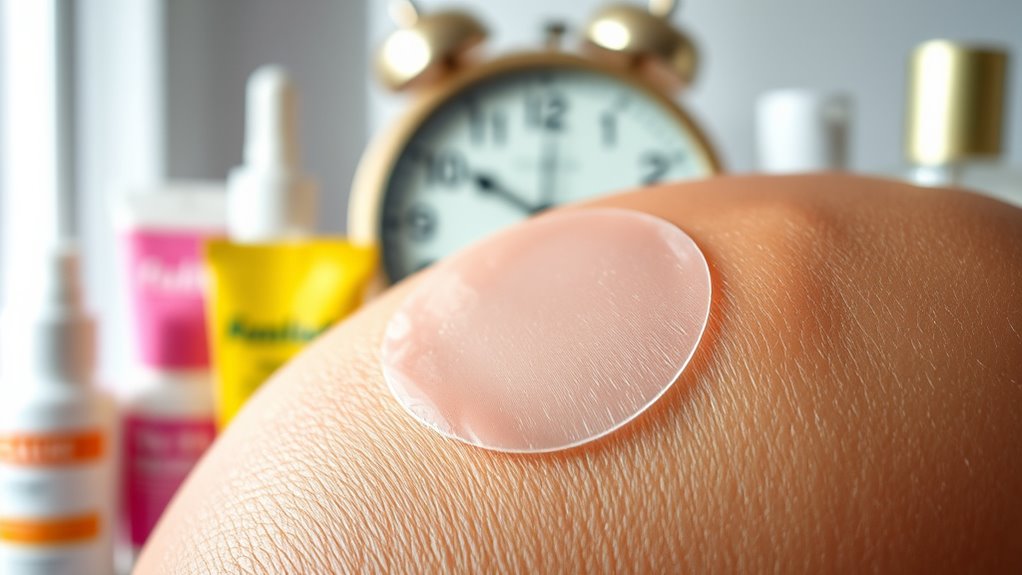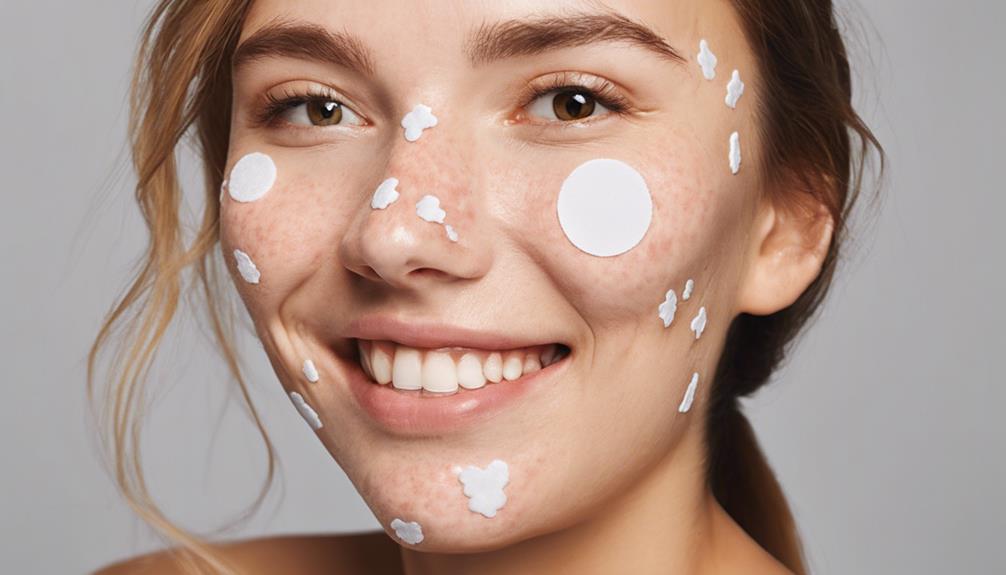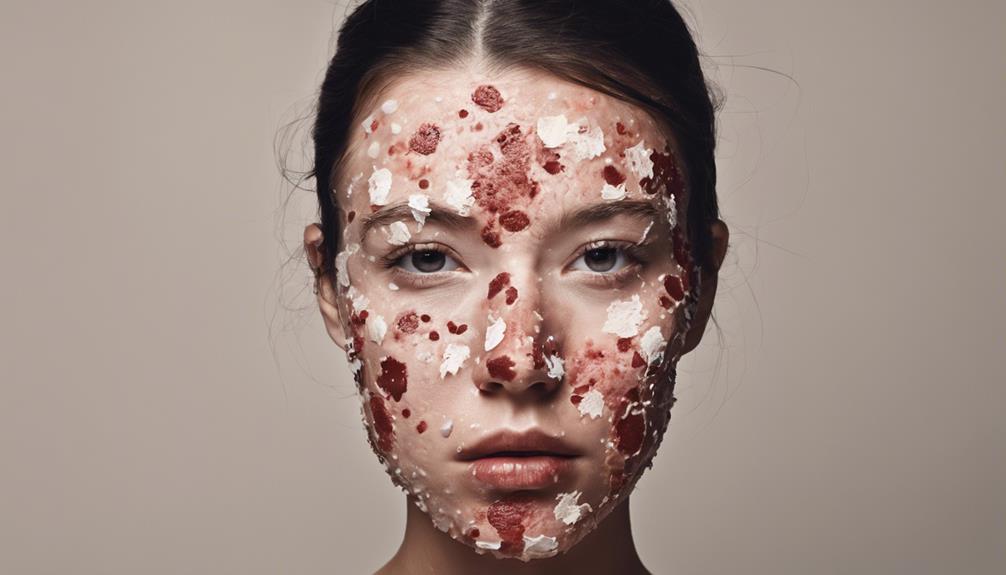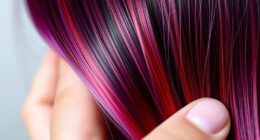You should leave a pimple patch on for about 6 to 8 hours to maximize its healing effects. This duration lets the patch absorb excess fluid and reduces swelling effectively. If you’re dealing with cystic acne, you can wear it for up to 24 hours. Make sure to check for any white or cloudy indicators, which show it’s time to swap it out. There’s a lot more to discover about different acne types and patch care!
Key Takeaways
- Leave pimple patches on for 6 to 8 hours for effective absorption of impurities and reduction of inflammation.
- For cystic acne, wearing patches for up to 24 hours can enhance healing benefits.
- Check patches regularly; remove them when they appear white or cloudy, indicating saturation.
- Overnight application is ideal for minimizing the risk of scarring and promoting quicker recovery.
- Start with shorter wear times for sensitive skin, gradually increasing as tolerated for optimal results.
Understanding Pimple Patches

When you’re dealing with a pesky pimple, understanding pimple patches can make a big difference in your skincare routine.
These patches are typically made from hydrocolloid, a gel-like substance that absorbs excess moisture, making them effective for healing pimples. The gummy texture helps draw out pus and fluid, reducing swelling and inflammation. Standard Hydrocolloid Patches are recommended to be worn for 6 to 8 hours to maximize their effectiveness.
Made from hydrocolloid, these patches absorb moisture and draw out pus, reducing swelling and promoting healing.
By creating a protective seal, they absorb oil and dirt while acting as a barrier against pollutants and bacteria. This prevents picking, which can lead to scarring.
Unlike traditional drying treatments, pimple patches keep your skin hydrated, promoting faster healing. They’re suitable for various skin types, including sensitive skin, thanks to their gentle formulation.
With regular use, they can be a game-changer in managing mild acne.
Recommended Duration for Use

To get the best results from your pimple patches, aim to leave them on for 6 to 8 hours. This timeframe allows the patch to effectively absorb impurities and work its magic on your skin. Additionally, the patches create a moist environment that speeds up healing, preventing scabs and scars.
If your patch turns white or cloudy, it’s time to remove it, as that indicates it’s done its job. For sensitive skin or patches containing actives like salicylic acid, you might prefer shorter durations.
In cases of cystic acne or inflamed pimples, longer wear can be beneficial, sometimes up to 24 hours. Just remember, always check the patch for saturation and replace it if it starts peeling off.
Proper timing is key to maximizing the effectiveness of your pimple patches.
The Benefits of Overnight Application

Leaving pimple patches on overnight offers a range of benefits that can greatly enhance your skin’s healing process.
First, they accelerate healing by absorbing excess fluid and reducing inflammation, helping to calm redness and swelling. The barrier they create also prevents you from picking or popping pimples, which can lead to scarring. Plus, they shield your skin from dirt and bacteria, promoting a healthier environment for recovery. Many patches are discreet, allowing you to wear them confidently while you sleep. Additionally, these patches are made from hydrocolloid material, which creates a moist environment that draws out pus and oil.
When applied at night, you benefit from extended healing time, often resulting in noticeable improvements by morning. Incorporating these patches into your bedtime routine makes treating breakouts easier and more effective.
Extended Wear: When and How

Although pimple patches are often used overnight, you can also benefit from extended wear throughout the day. These patches can be left on for up to 24 hours, making them perfect for stubborn blemishes that need extra attention. Thinner designs guarantee you can wear them discreetly, reducing inflammation and redness while protecting the area from irritants. During extended wear, regularly check the patch to confirm it hasn’t peeled off due to saturation. Additionally, the patches are made from hydrocolloid material, which helps absorb excess fluid effectively. Apply them on clean, dry skin for best adhesion, and replace them if they lose effectiveness. Just be mindful of your skin type; sensitive skin might react to prolonged wear, so adjust as needed. This approach maximizes healing and absorption of pus and oil.
Factors Affecting Patch Duration

Several factors influence how long you should leave a pimple patch on, impacting its effectiveness and your skin’s response.
First, consider the type of acne. Whiteheads typically benefit from 6-8 hours, while cystic pimples may need over 8 hours for ideal reduction. Your skin’s sensitivity also plays a role; if you have sensitive skin, you might want shorter wear times. Additionally, pimple patches are recommended for at least six hours for optimal results.
Patch formulation matters too—hydrocolloid patches are best left on for 6-8 hours, but those with active ingredients may require shorter durations to prevent irritation.
Finally, think about your usage time; overnight applications usually yield the best results. By considering these factors, you can tailor your patch duration for the best outcome.
Different Types of Acne and Their Needs

Understanding the different types of acne helps you choose the right pimple patch and treatment duration for each specific need.
Blackheads and whiteheads, being comedonal acne, benefit from patches that unclog pores effectively.
Papules and pustules fall under inflammatory acne; you’ll need a patch that targets inflammation and pus to reduce redness and swelling.
For severe cases like cysts and nodulocystic acne, deeper treatments are often necessary, and patches may not suffice on their own. Acne is linked to hormonal changes during puberty, but can start at any age, which further emphasizes the importance of identifying your acne type.
Identifying your acne type is essential, as mild cases require less aggressive treatment, while moderate to severe cases might need a combination of patches and other medications. Tailoring your approach guarantees you address your acne effectively and minimize the risk of scarring.
How to Remove and Replace Patches

Removing and replacing pimple patches correctly is essential for achieving the finest results. Start by washing your hands to prevent bacterial transfer. Gently peel the patch off from the edges to minimize irritation, and dispose of it afterward. Inspect the area for any residue or irritation, and wash the skin before applying a new patch. You should replace the patch if it turns white, loses adhesion, or reaches the 6-8 hour mark. If the pimple shows improvement, it’s a good sign. After removal, apply a moisturizer to keep your skin hydrated. It’s important to note that hydrocolloid patches create a clean and protected environment for healing. Monitor your skin’s sensitivity when reapplying patches, and verify the new patch adheres well for maximum effectiveness. Avoid popping pimples during this process to prevent further irritation.
Enhancing Effectiveness With Skincare

To maximize the effectiveness of pimple patches, integrating them into your skincare routine is crucial.
Start by choosing the right patch type for your needs—medicated patches with salicylic acid tackle stubborn acne, while hydrocolloid patches help absorb impurities. Apply the patch at the first sign of a breakout, ideally overnight for best absorption.
Choosing the right pimple patch type is essential for effective acne treatment—medicated for stubborn spots, hydrocolloid for impurities. Apply at breakout’s first sign.
Confirm your skin is clean and dry before application to enhance adhesion. Avoid touching the patch after placing it, and press firmly to eliminate air bubbles. Additionally, consider your skin type: if you have oily skin, opt for patches with salicylic acid, while those with sensitive skin should choose hypoallergenic options. This thoughtful approach will help you achieve faster healing and better results. Hydrocolloid patches are particularly effective for retaining moisture and extracting impurities from blemishes.
Listening to Your Skin: Individual Needs

While every skin type is unique, listening to your skin’s specific needs is essential for effective pimple patch use.
Start by evaluating your acne type; patches work best on surface-level pimples and whiteheads. If you have sensitive skin, opt for gentler patches and shorter wear times to prevent irritation.
Choose the right patch type, as ingredients like salicylic acid or hydrocolloid cater to different needs. Monitor your skin’s reaction closely—look for signs of irritation or changes in adhesion.
Begin with shorter durations and gradually increase wear time based on your skin’s tolerance. Finally, remember to keep your skin hydrated post-patch removal for best healing.
Tailoring your approach can make all the difference in your skincare routine.
Frequently Asked Questions
Can I Wear Makeup Over a Pimple Patch?
Absolutely, you can wear makeup over a pimple patch! Just make sure to choose a patch that fully covers the blemish.
When applying makeup, do it gently to avoid dislodging the patch. Opt for lightweight products and blend carefully around the edges for a natural look.
This way, your patch stays effective while protecting the pimple from makeup-related irritation and infection. Plus, it helps create a smooth canvas for your makeup application.
How Do I Choose the Right Size Patch?
Choosing the right size patch is vital for effective acne treatment.
You’ll want a patch that’s slightly larger than the pimple to guarantee full coverage. For oily skin, opt for a more precise fit to prevent slipping.
Transparent patches work great for daytime use, blending seamlessly with your skin.
Consider brands that offer multiple sizes in one package, giving you flexibility for different blemish sizes.
Proper sizing helps maximize absorption and minimizes irritation.
Are Pimple Patches Safe for Sensitive Skin?
Pimple patches can be safe for sensitive skin, especially if you choose the right ones.
Look for dermatologist-recommended options, like hydrocolloid patches designed for sensitive skin. These patches are often fragrance-free and reduce the risk of irritation.
Always apply them to clean, dry skin and remove them gently to avoid discomfort.
If you notice any irritation, consider shorter wear times or switching to non-medicated patches for better results.
Can I Use Multiple Patches at Once?
Yes, you can use multiple patches at once!
If you’ve got several breakouts, applying different patch types tailored to each pimple can enhance your treatment. Just make sure your skin is clean and dry before application to avoid irritation.
Watch out for sensitivity; it’s best to start with shorter wear times if you’re prone to irritation.
Using multiple patches can speed up healing and minimize scarring, so give it a try!
What Should I Do if a Patch Irritates My Skin?
If a patch irritates your skin, promptly peel it off to prevent persistent pain.
Prioritize soothing solutions like gentle cleansers and calming creams to care for your complexion. Avoid abrasive products that could worsen the irritation.
Consider consulting a dermatologist for tailored treatment tips if irritation lingers.
To prevent future flare-ups, prepare your skin properly, choose patches made for sensitive skin, and always read labels to dodge potential allergens.
Conclusion
To sum up, knowing how long to leave a pimple patch on can make all the difference in your skincare routine. Whether you’re using it overnight or for an extended period, listen to your skin and adjust as needed. With the right approach, those pesky pimples can vanish faster than a magician’s rabbit! Remember, everyone’s skin is unique, so find what works best for you and watch your confidence soar as your skin clears up.









